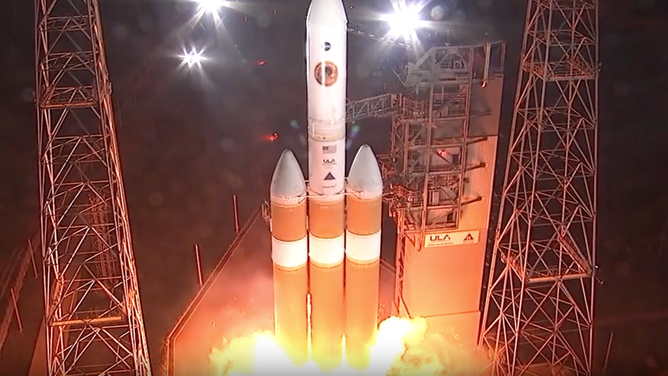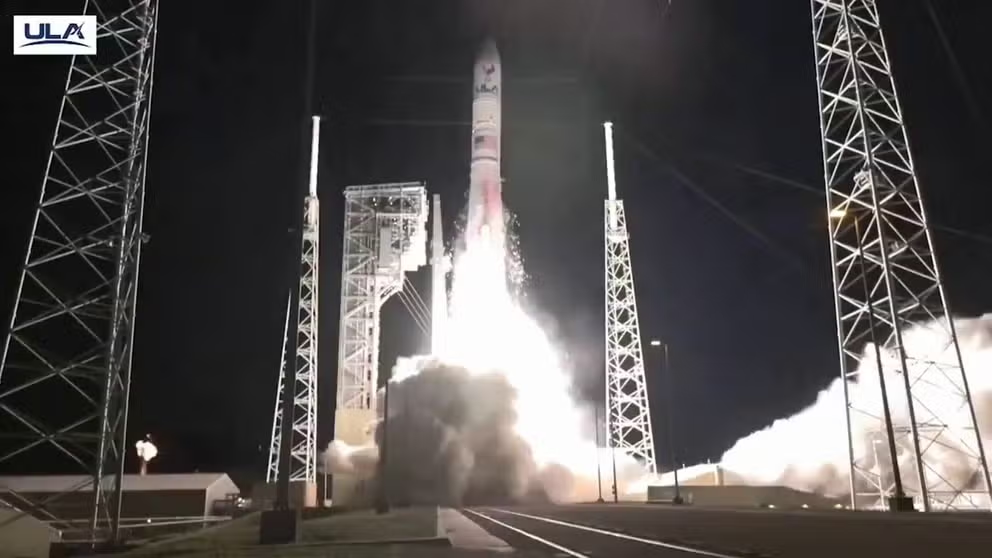Final Delta IV Heavy rocket gets new launch date after scrub
United Launch Alliance plans to try again on April 9th at 12:53 p.m. EDT to launch the Delta IV Heavy rocket from Cape Canaveral, Florida, with the NROL-7 payload. The mission will conclude the 60-year history of the Delta rocket family.
Inaugural launch of ULA's Vulcan rocket
ULA's Vulcan rocket launches for the first time carrying the Peregrine Moon lander to space. The liftoff happened from Cape Canaveral, Florida on Jan. 8. (video: ULA)
CAPE CANAVERAL SPACE FORCE STATION, Fla. – United Launch Alliance (ULA) has set a new launch date for the final Delta IV Heavy rocket after a technical issue caused a scrub for the first attempt.
ULA attempted to launch the Delta IV Heavy rocket from Launch Complex 37 at Cape Canaveral Space Force Station in Florida on March 28th. However, the launch was scrubbed due to an issue with a pump on the fuel pipeline to the launchpad.
The company plans to try again on April 9th at 12:53 p.m. EDT to launch the NROL-70 payload into orbit for the National Reconnaissance Office (NRO).
ULA said the launch "was scrubbed due to an issue with the gaseous nitrogen pipeline, which provides pneumatic pressure to the launch vehicle systems."

A United Launch Alliance (ULA) Delta IV Heavy rocket is transported from the Horizontal Integration Facility to Space Launch Complex-37 in preparation to launch the NROL-70 mission for the National Reconnaissance Office. Photo credit: United Launch Alliance
(ULA)
ULA CEO Tory Bruno wrote on X, formerly known as Twitter that the gaseous nitrogen pipeline operated by NASA serves several launchpads on Florida's Space Coast.
"And, yes, there is a ‘gas meter’ so companies pay for what they use," Bruno wrote on March 31st. "The issue is with pumps on that pipeline. They are working it hard right now."
When it happens, this will mark the final launch of the Delta IV Heavy rocket, concluding the 60-year history of the Delta rocket family.
The Delta legacy
The history of the Delta rocket program dates back to the late 1950s when NASA started it. The Delta IV Heavy has been dubbed the "most metal of rockets" because of its fiery display during launch.
Ahead of the Delta finale, Bruno explained why the rocket "lights itself on fire before it goes to space."
The rocket uses a half-million gallons of fuel and has three side-by-side booster cores, each with Aerojet Rocketdyne RS-68A engines that provide a combined 2.1 million pounds of thrust at liftoff. To prepare the rocket's RS-68A engines, very cold cryogenic hydrogen propellant flows into the engines before they ignite.

ULA's Delta IV Heavy rocket launches from Cape Canaveral, Florida sending NASA's Parker Solar Probe into space on Aug. 12, 2018.
(ULA/NASA)
"Hydrogen is lighter than air, so after it flows through the engine and the flame trench, it then rises," Bruno said.
After the main fuel load is dropped and the engines ignite, the flame travels where the hydrogen clings to the booster's side.
At 233 feet tall, the Delta IV Heavy would tower above the first Delta rocket at just 90 feet tall. Ultimately, the first Delta launch in 1960 was not a success. However, the Delta rocket quickly began establishing a history of successful missions. Versions of Delta rockets launched eight missions to Mars for NASA, including Spirit and Opportunity rovers.
The Delta IV Heavy Launch vehicle started launching in 2002. All but four of its 16 missions were for the NRO. The penultimate liftoff of the rocket happened in June, launching the NROL-68 mission.
ULA is replacing its workhorse rocket, the Atlas V, and the Delta Heavy with the new Vulcan rocket. The Atlas series uses Russian-made RD-180 engines. Vulcan uses American-made hardware, including Blue Origin and Aerojet Rocketdyne engines.
The company’s inaugural Vulcan launch happened in January, launching Astrobotic’s robotic mission to the Moon. While Astrobotic’s mission did not ultimately reach the Moon, the lunar orbital assist from ULA went flawlessly, according to both companies.
